2002 Totcky Award Winner

Submitted by Randy O.
|
Nell called Ray H. and asked if he wanted to go over with us and look at the Hudsons and the T so Saturday, February 16, 2002, the three of us headed over to Tuscumbia. We located the Hudsons and the ?41 was by far in the best condition of the three and was in fact driveable and fairly decent looking but it was not only a little pricey for its condition, but we just did not have any desire to pursue it. The 1954 Hudson was a black (somewhat rusty) 4-door Hornet Special. The Portawall tires were mostly flat, the head was off the engine, and it looked awful. The car had been sitting outside in Tuscumbia for 3 years and in the Florence area for 22 years before that. A challenge indeed (and too much for us to pursue even for the $450 asking price). We followed Steve over to another area and looked at the Model T that Ray was more interested in. We even took a ride in the T. But following that, we told Steve there was nothing there we were wanting to buy but that we would get word out via the various AACA and Hudson newsletters. A few evenings later we received an email from Steve stating he would take $400 for the Hornet Special and that included an extra 262 head plus an older 212 head (although the Hornet used the 308 engine). We decided to buy the car and on February 23, we drove back to Tuscumbia along with Ed H. in his big truck and trailer and hauled the car back home. 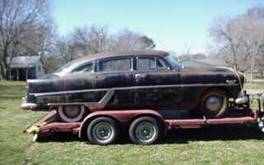
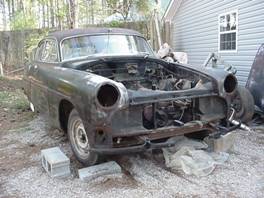
Ed maneuvered the Hornet behind the garage where we would cover it and work on it in our spare time. Later that day I got inside the car and was amazed at how well the chrome on the dash cleaned up with some Never Dull. That was encouraging. The big holes in the floorboard were not. The next week-end we began removing the bumpers, grille, and sill plates (only using the Dremel tool cutter a few times). And Nell and I both took off the following Monday (President?s Day) and proceeded to strip the car down and by Monday evening had removed the side stainless trim, door handles, ornaments, and scripts. The following evenings (as daylight permitted) and on weekends we continued to disassemble the car. By the 28th of February we had removed just about all the engine external components such as the starter, generator, radiator, horns, etc. It was in doing this that I realized every single piece of wiring outside the firewall would have to be replaced. So I picked up the ?54 Hudson manual and from the electrical wiring diagram, started writing down colors of wire, gages of wires, and lengths needed and from that placed an order for new wiring. A tremendous amount of cleanup and disassembly continued through March. Luckily, all the stainless on the car polished out except for two pieces that we were able to acquire from a Hudson vendor in Arizona. We ordered all new brake components obtainable from CarQuest and all the brake lines, wheel cylinders, shoes, master cylinder, etc. were replaced. New fuel lines were installed with an electric backup pump placed near the gas tank. And the gas tank, amazingly enough, was clean -- so clean I did not even bother to flush it out. It had just a tiny bit of rust at the drain plug, but other than that was just fine?.unbelievable, but true. I cleaned up the sending unit and checked it out and it read accurately. We found this to just be incredible. I checked out the water temperature gauge by heating up a new sending unit and the gauge worked. The idiot lights on the dash also checked out once we replaced the bulbs. New window glass was cut and we installed it in six of the windows. Once the new wiring arrived, I meticulously rewired every wire one by one and once all were done, placed a battery in the car and proceeded to check out everything. As it would happen, some things worked, some did not, but in due time all the lights, gauges, and electricals worked ok, although the turn signal lights gave us some problems for a time. Much undercarriage work and a lot of bodywork continued to be performed including fashioning new front floorboards from discarded RUUD air conditioner panels. 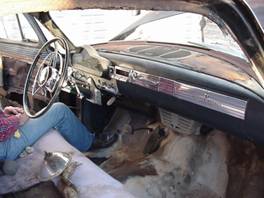
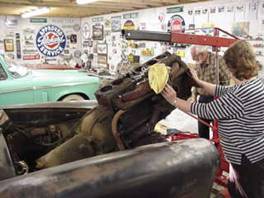
Now, about that headless engine with mud and crud in it. After a combined 18 hours of effort among Ray, Nell, and myself and thanks to Ed?s engine hoist, the big 308 engine and Hydramatic transmission were removed from the car on April 6. From that point through April 18th, the engine was taken apart (mostly by Ray with us handing him tools and holding things). On May 3rd, the engine and aluminum head were transported down to Southern Cylinder Head, a machine shop Ray had located. The head would have to be machined and the cylinders bored. It was actually not until August 9th that we got the engine back. On August 17th, Ray and I got the engine hoisted back into the car. A newly rebuilt carburetor, starter, generator, water pump, fuel pump, and 4-passage radiator were then assembled onto the engine. For the next 3 days/evenings we hung components on the engine and hooked up lines and wires. Now, after 766 hours of accumulated time, late on the evening of August 20, we went for launch but no go. The engine would not start. We saw some sparks at the firewall?turned out the engine was not grounded properly, there was no rubber accelerator boot and the result was this sparking of the accelerator metal rod. We resolved that problem, but after 4 more frustrating hours there was still no ignition. The next evening Ed dropped by to check on our progress. Ed and Ray worked out that the problem was that the timing was off. Somehow, when we had replaced the Oil Pump gear, we must have been off a tooth or two. With the distributor turned more than customary, the engine fired up but there was a big time water leak out the heater core overflow. So we shut it down for the night. The next night with the heater core plugged, we went for ignition again and it fired up but huge leaks developed under the car. These appeared to be both oil and transmission and these were serious leaks. Tired, disappointed, and frustrated, we called it quits for the night as it was quite late. The next afternoon, I crawled under the car for a looksee and Eureka! the transmission drain plug was loose and it seems the appearance of both a tranny leak and an oil leak were just the transmission. We tightened the drain plug and once again went for ignition and finally, on August 23rd, after 811 hours of work, we had a running engine. Next we put a new Heater Control Valve and a rebuilt heater core in the car, along with getting other things done. August 27th we had the first road test and it was just wonderful. No leaks and the engine and transmission both responded favorably. Nell installed carpet and Ray and Nell installed a new headliner (without removing the rear window glass which the service manual stated was necessary)...little did they anticipate modern ingenuity. Now that the engine was running, it was time to drive to the upholstery shop in Hartselle which we did a little nervously on September 16th, getting the car back on October 16th, just in time for its first showing at the U.S. Space & Rocket Center where the car attracted many folks and actually won a trophy (despite still being in primer). On November 9, we decided it was tour time for the Hornet, so we drove it approximately 110 miles round trip up to Prospect, Tennessee as part of a middle Tennessee Studebaker and AACA tour, and other than running a little too warm, the car performed just fine. The running too warm was traced to a missing thermostat O-ring. Then on December 16th we drove the car to the paint shop for its new two-tone metallic gray and blue paint. At that point, 1024 hours had been expended on restoration of the car. Once the Hornet returned from the paint shop, we began the task of re-installing bumpers, grille, chrome, ornaments, and side trim. We plan to show it with its new coat of paint in March 2003 at the Studebakers and Orphan Cars show at Shelbyville, TN. And then, of course, we plan to show it at the Tims Ford Region AACA and NAR AACA shows in May, followed by various other shows and events during the year. But once again, with much help and advice from old car friends we were able to save a ?Special? car. 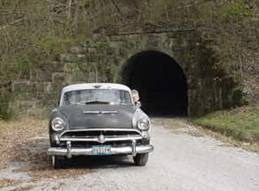
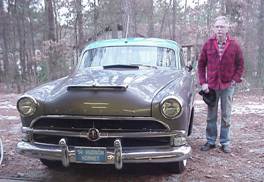
|
 |
Contact Webeditor |
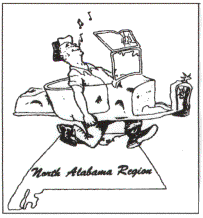
|